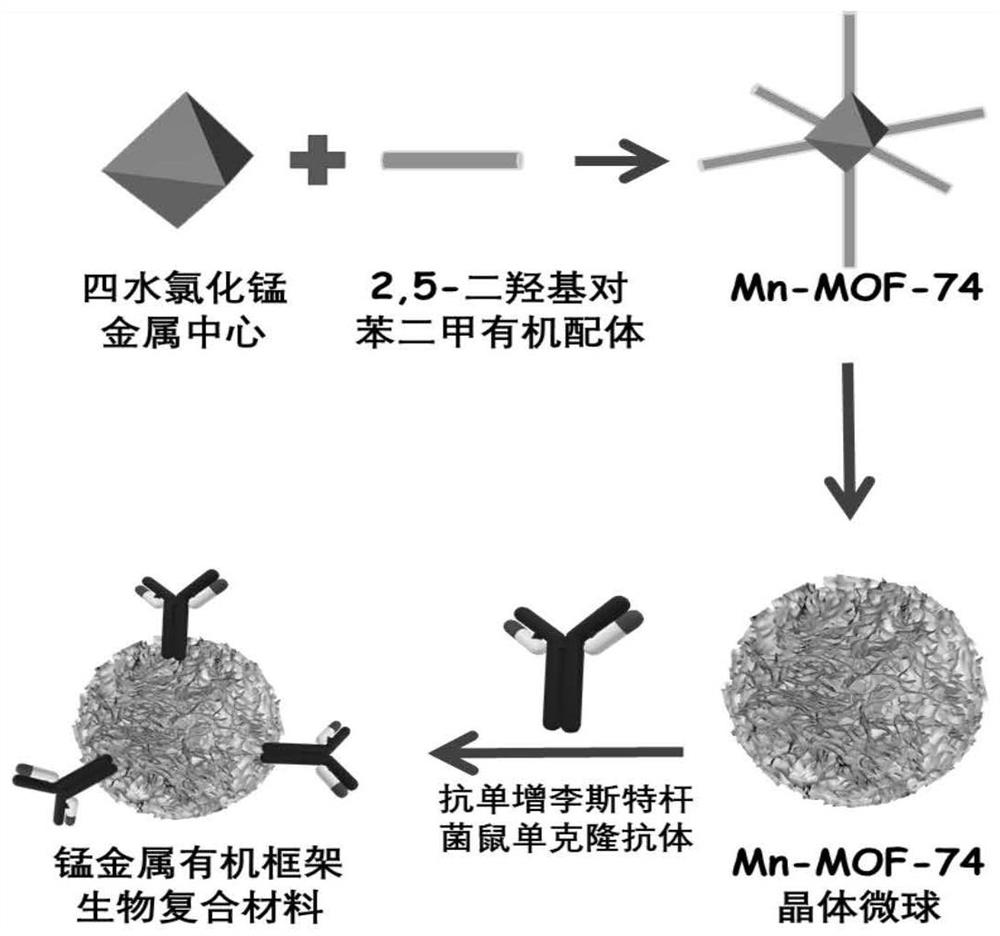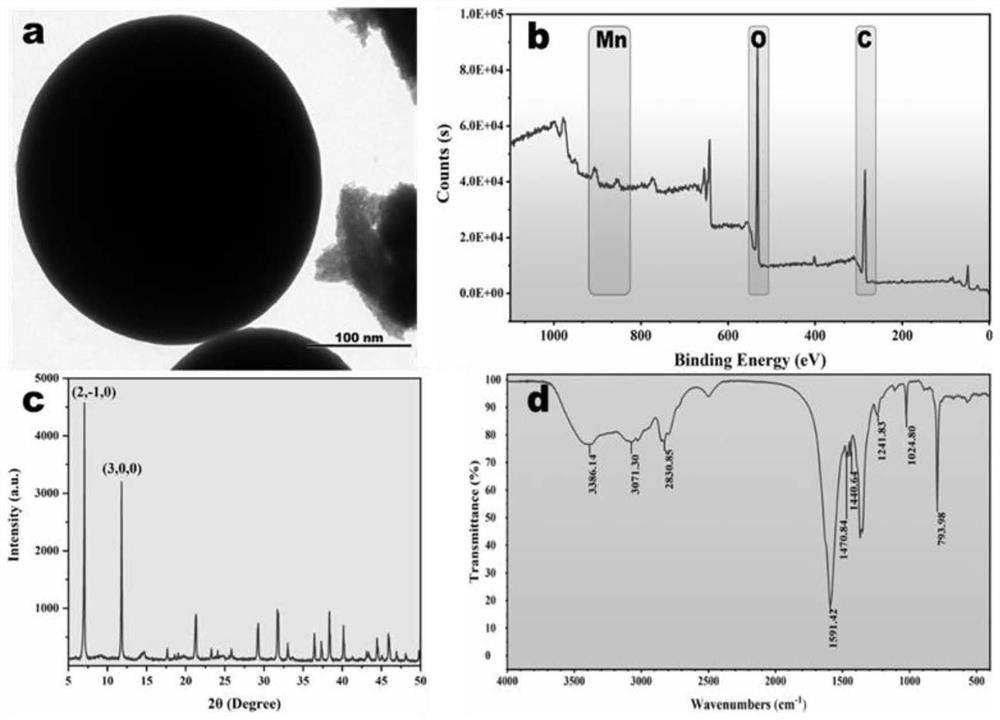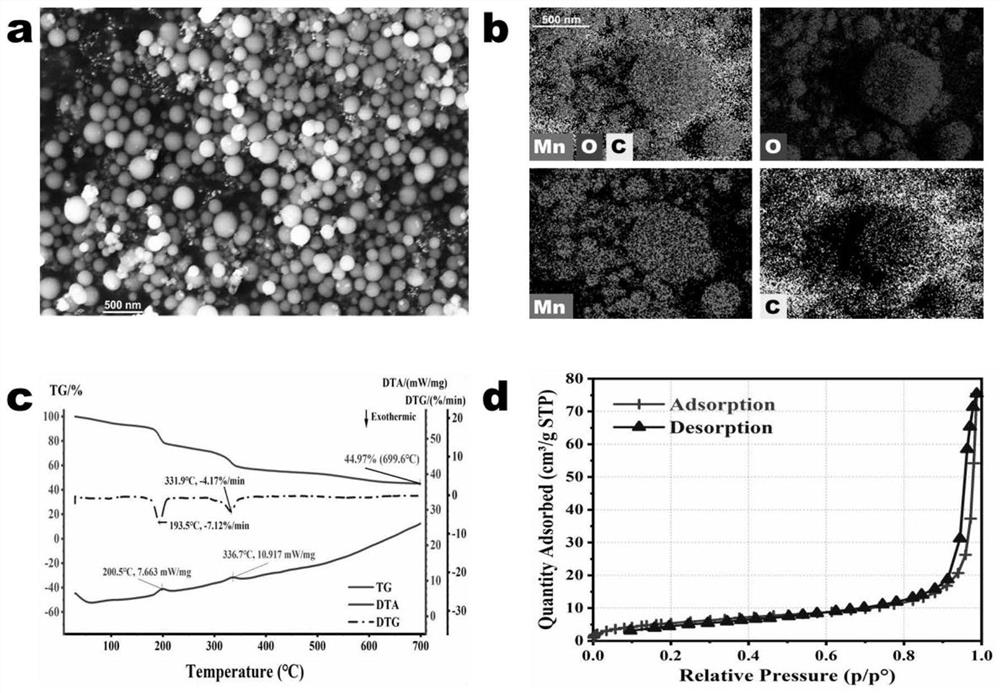Manganese metal organic framework (MOF) biological composite material and application thereof in detection of food-borne pathogenic bacteria
A composite material, organic framework technology, applied in the direction of analyzing materials, material resistance, material electrochemical variables, etc., can solve the problems of low conductivity, interference, reduced detection sensitivity and accuracy, etc.
- Summary
- Abstract
- Description
- Claims
- Application Information
AI Technical Summary
Problems solved by technology
Method used
Image
Examples
Embodiment 1
[0043] Example 1, preparation of manganese metal organic framework biocomposite material
[0044] The schematic flow chart of the preparation method is as figure 1 shown.
[0045] (1) Preparation of MnCl 2 4H 2O (439.2mg, 2.22mM, 3.3Equiv) and 2,5-dihydroxyterephthalic acid (DHTP, 133.2mg, 0.672mM, 1Equiv) in 60mL of DMF-methanol-water (1:1:15, V / V / V) mixed solvent for 20min. The mixed solution was transferred to a 100mL polytetrafluoroethylene reactor sleeve, crystallized at 140°C for 24 hours, dried after centrifugal purification, and the product was brownish yellow solid powder (spherical structure under the electron microscope).
[0046] The TEM figure, XPS characterization figure, XRD characterization figure and FTIR characterization figure of the Mn-MOF-74 nanometer microspheres prepared in this embodiment are as follows figure 2 (a), figure 2 (b), figure 2 (c) and figure 2 As shown in (d), it can be seen that the particle size of Mn-MOF-74 microspheres is 2...
Embodiment 2
[0051] Example 2, Manganese metal organic framework biocomposite material as an impedance detection mode establishment of immunosensor
[0052] Weigh 10 mg of manganese metal-organic framework (Mn-MOF-74) nanospheres, and use deionized water for 10-fold gradient dilution to prepare an aqueous solution with a concentration ranging from 10 ng / mL to 10 μg / mL, and add a hydrogen peroxide solution with a concentration of 100 μM, After centrifugation, take 10 μL of the supernatant solution and add it dropwise to the working electrode working area of the electrochemical workstation to test the impedance signals of electrochemical sensors with different concentrations.
[0053] It can be seen from the test that the impedance signal range in the deionized aqueous solution of the manganese metal organic framework biocomposite material in the concentration range of 10ng / mL~10μg / mL is 1116~10493Ω (see Table 1), and the linear equation is Y=1378X-738.68, R 2 = 0.9797.
[0054] The abov...
Embodiment 3
[0057] Example 3. Application of manganese metal organic framework immunosensor in the detection of Listeria monocytogenes in water and milk
[0058] Schematic diagram of the electrochemical detection technology for Listeria monocytogenes in water and milk based on metal-organic framework biocomposites Figure 4 shown.
[0059] Set the concentration to 10 8 The pure culture of CFU / mL Listeria monocytogenes was added to water and milk samples, and then the added samples were diluted with a 10-fold gradient in water and milk samples to prepare a concentration range of 10 0 ~10 4 CFU / mL of bacterial test solution. 100 μg of immunomagnetic beads were added to each diluted sample, and after incubation on a shaker for 20 minutes (40 rpm, room temperature), the mixture was magnetically separated for 1 minute, and then washed with PBS buffer and PBST buffer (0.05% Tween-20 PBS buffer, V / V) washed 3 times. Add 100 μg of MnMOF biocomposite to the magnetically separated samples and ...
PUM
| Property | Measurement | Unit |
|---|---|---|
| Particle size | aaaaa | aaaaa |
Abstract
Description
Claims
Application Information
 Login to View More
Login to View More - R&D
- Intellectual Property
- Life Sciences
- Materials
- Tech Scout
- Unparalleled Data Quality
- Higher Quality Content
- 60% Fewer Hallucinations
Browse by: Latest US Patents, China's latest patents, Technical Efficacy Thesaurus, Application Domain, Technology Topic, Popular Technical Reports.
© 2025 PatSnap. All rights reserved.Legal|Privacy policy|Modern Slavery Act Transparency Statement|Sitemap|About US| Contact US: help@patsnap.com



